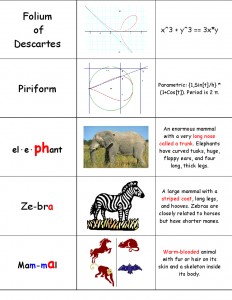Studying Tips: A Study Strategy for Vocabulary and Anything Else you Need to Memorize for that Multiple Choice Test!
We can take flash cards to another level when working with vocabulary and other concepts by adding definitions or descriptors to our terms and visual clues. Three Card Match is a memory game that puts the concepts of print, color, and visuals together using vocabulary, definitions, or mnemonics along with visual clues.
One year, I had a group of students who were in a general education classroom for the very first time. We were doing inclusion in a class of 27 kids, 13 of which were on an IEP, with only two receiving modified tests. They had to learn 20 constellation names, the unique features of those constellations, and what the constellation looked like as part of the curriculum.
 These students with special needs had never been required to memorize anything so complex in their self-contained classrooms. I truly did not believe they were capable of memorizing that much information. I was ‘raised’ as a teacher in an age where we learned that if something was difficult for students, we’d find a work-around rather than require students to do a task that fell into the realm of their disability.
These students with special needs had never been required to memorize anything so complex in their self-contained classrooms. I truly did not believe they were capable of memorizing that much information. I was ‘raised’ as a teacher in an age where we learned that if something was difficult for students, we’d find a work-around rather than require students to do a task that fell into the realm of their disability.
Since this memorization task was part of the general curriculum standards, we had to find a way to help the students be successful. I needed to teach them some studying tips, fast! We used Three Card Match to assist students in the process of learning and remembering the constellation information. Every student passed their test. I was humbled. I really didn’t believe at the onset that the students on my caseload and in this inclusion class were capable of succeeding with the assignment.
For Your Own Studying Tips: How to Make Three Card Match Strategy Cards
Use Three Card Match any time you have terms or items you need students to remember. If you’ve got a ready-made matching test, cut it up so there’s a word and a matching statement that goes with the word. Then add a memory cue: a picture, a diagram, or a personal experience and you’ve got your Three Card Match. The third card is typically something that helps students remember.
Teachers, you can use this technique in your lesson plan. Everything you need to implement the studying tips lesson is here.
Materials:
- Index Cards
- Choose three of the following card colors: pink, green, blue, yellow, or white.
- If you only have white cards or white paper, color-code the cards. For example:
- Put a yellow dot or stripe on the word cards.
- Put a green dot or stripe on the picture cards.
- Put a pink dot or stripe on the definition cards, and so on.
- Pictures
- Of the item being reviewed
- Something related to the concept being reviewed
- A mnemonic picture to form an association
Instructions:
- Break down what they have to memorize into three related concepts, facts, pictures, meanings, etc.
- Each card should contain one ‘item,’ such as a word, picture or definition.
- Label the back of each card in a set with a number so children can turn the card over and self-correct.
For example:
The word ‘elephant,’ the picture of the elephant, and the definition of the word ‘elephant’ would all be numbered #1 on the back.
The word ‘zebra,’ the picture of a zebra, and the definition of the word ‘zebra’ would all be numbered #2, etc.
Hint: Children can make these sets from photocopied masters. They are made with a word processor on the computer using the table function. Children simply cut and paste the items on index cards. I don’t recommend forcing children to hand write their cards unless they can print them clearly and legibly in a timely manner. Avoid cursive. Words should be printed legibly, or with a clear san serif font, when using a computer, for greatest memory retention.
Options for use:
- Children can match the cards on their own as a review.
- Children can pair up with a partner to match the cards.
Remember, research indicates that we learn the most when we teach others. When two people work together to study, they are teaching each other.
Here’s a video of the Three Card Match Using these Studying Tips!
<


